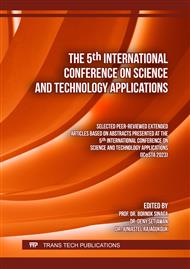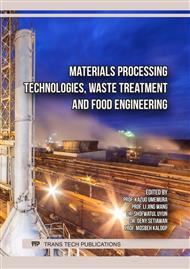[1]
J. Wahyudi, H.T. Prayitno, and A.D. Astuti, Utilization of Plastic Waste as Raw Material for Making Alternative Fuels, R&D Journal 15 (2018) 058067.
Google Scholar
[2]
S.N.H.M. Azmin, and M.S.M. Nor, Development and characterization of food packaging bioplastic film from cocoa pod husk cellulose incorporated with sugarcane bagasse fibre, Journal of Bioresources and Bioproducts 5 (2020) 248255..
DOI: 10.1016/j.jobab.2020.10.003
Google Scholar
[3]
S.N. Fauziyah, A.S. Mubarak and D.Y. Pujiastuti, Application of glycerol on bioplastic based carrageenan waste cellulose on biodegradability and mechanical properties bioplastic, In IOP Conference Series: Earth and Environmental Science 679 (2021) 012005.
DOI: 10.1088/1755-1315/679/1/012005
Google Scholar
[4]
K. Kanagesan, R. Abdulla, E. Demam, M.K. Sabullah, N. Govindan and J.A. Gansau, A sustainable approach to green algal bioplastics production from brown seaweeds of Sabah, Malaysia, Journal of King Saud University – Science 34 (2022) 102268.
DOI: 10.1016/j.jksus.2022.102268
Google Scholar
[5]
Y. Yu, D.E. GriffinLaHue, C.A. Miles, D.G. Hayes and M. Flury, Are micro- and nanoplastics from soil-biodegradable plastic mulches an environmental concern, Journal of Hazardous Materials Advances 4 (2021) 100024.
DOI: 10.1016/j.hazadv.2021.100024
Google Scholar
[6]
S. Nigam, A.K. Das and M.K. Patidar, Synthesis, characterization and biodegradation of bioplastic films produced from Parthenium hysterophorus by incorporating a plasticizer (PEG600), International Journal of Environmental Challenges 5 (2021) 100290.
DOI: 10.1016/j.envc.2021.100280
Google Scholar
[7]
G. Atiwesh, A. Mikhael, C.C. Parrish, J. Banoub and T. Tle, Environmental impact of bioplastic use: A review, Heliyon 7 (2021) e07918.
DOI: 10.1016/j.heliyon.2021.e07918
Google Scholar
[8]
N.K. Kalita, A. Sarmah, S.M. Bhasney, A. Kalamdhad and V. Katiyar, Demonstrating an ideal compostable plastic using biodegradability kinetics of poly(lactic acid) (PLA) based green biocomposite films under aerobic composting conditions, Environmental Challenges 3 (2021) 100030.
DOI: 10.1016/j.envc.2021.100030
Google Scholar
[9]
M. Pradeep, F. Rahul and T. Thanckachan, Investigations of chitin and coconut fiber reinforcements on mechanical and moisture adsorption properties of corn starch bioplastics, Proceedings (2022) 2214-7853.
DOI: 10.1016/j.matpr.2021.12.585
Google Scholar
[10]
E. Ansink, L. Wijk and F. Zuidmeed, No Clue about Bioplastics, Ecolofy Economics 191 (2022) 107245.
DOI: 10.1016/j.ecolecon.2021.107245
Google Scholar
[11]
S.N.H.M. Azmin, N.A. liah and M.S.M. Nor, Development and characterization of food packaging bioplastic film from cocoa pod husk cellulose incorporated with sugarcane bagasse fibre, Journal of Bioresources and Bioproduct 5 (2020) 248-255.
DOI: 10.1016/j.jobab.2020.10.003
Google Scholar
[12]
G. Bishop, D. Styles and P.N.L. Lens, Enviromental performance comparison of bioplastocs and petrochemical plastics: A Review of life cyc;e assessment (LGA) methodolofical decisions, International Journal of Resources, Convervation & Recyling 168 (2021) 105-451.
DOI: 10.1016/j.resconrec.2021.105451
Google Scholar
[13]
L. Behera, M. Mohanta and A. Thirugnanam, Intensification of yam-starch based biodegradable bioplastic film with bentonite for food packaging application, Enviromental Technology & Innovation 25 (2022) 102180.
DOI: 10.1016/j.eti.2021.102180
Google Scholar
[14]
B.Y. Alashwal, M.S. Bala, A. Gupta, S. Sharma and P. Mishra, Improved properties of keratin-based bioplastic film blended with microcrystalline cellulose: A comparative analysis, Journal of King Saud University-Science 32 (2020) 853-857.
DOI: 10.1016/j.jksus.2019.03.006
Google Scholar
[15]
B.A. Harsojuwono, W. Arnata and S. Mulyani, Biodegradable Plastic Characteristics of Cassava Starch Modified in Variations Temperature and Drying Time, Provided by International Institute for Science, Technology and Education (IISTE) E-Journals (2017) Vol.49.
Google Scholar



